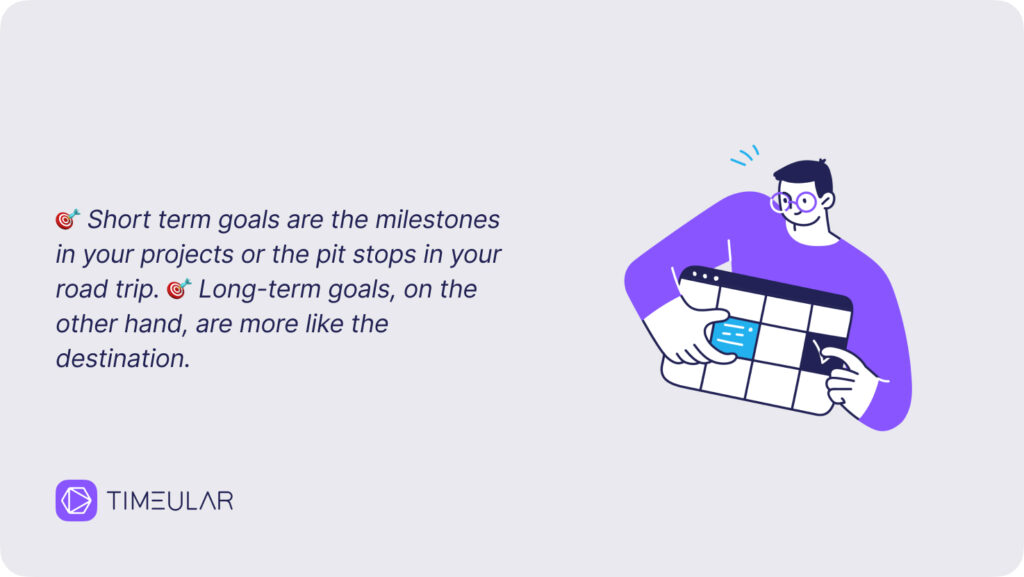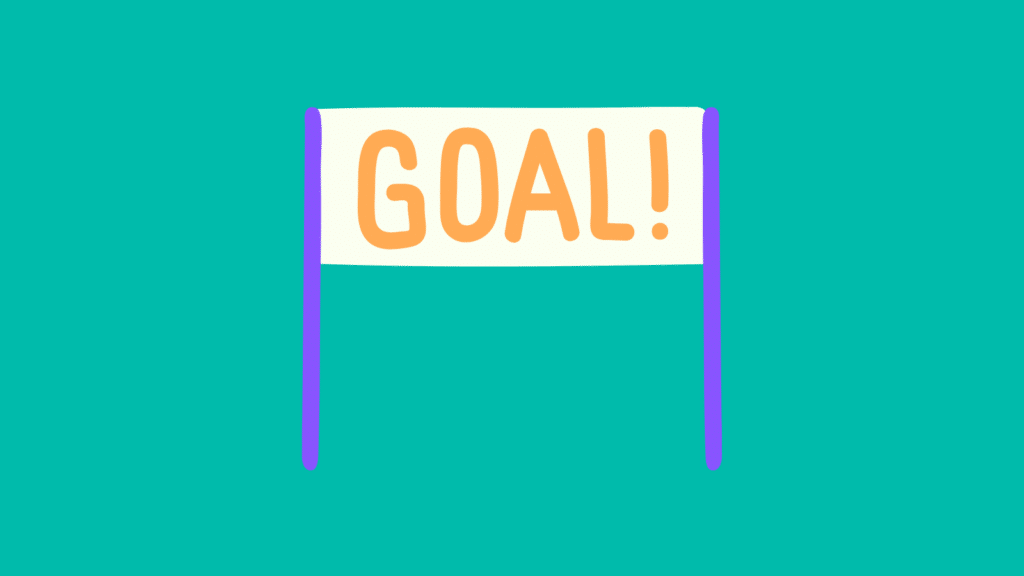Kort- og langsigtede mål (plan, eksempler)
Short-term goals, medium-term goals, long-term vision…it’s overwhelming, I get it. That is why this article will teach you how to set goals, their roles, and why you need both short and long-term goals.
Before we start, did you know that the mere action of setting a goal secrets dopamine in your brain? Imagine the impact of accomplishing them on your brain! But first, let’s unpack how to set goals!

What are short-term and long-term goals?
As a start, you need to know that short-term and long-term goals are building upon each other, so you can’t set only long-term goals. Or… you could, but you’d make your life and goal achievement much harder. Why? Because we’re all setting New Year’s resolutions and kissing them goodbye by the end of January.
They are too big and unrealistic. We need to find a middle ground – a way to break the audacious goal into stepping stones, which leads us to short-term goals.
What are short-term goals?
Short-term goals are the so-called milestones in project management or the pitstops in your road trip. As research from the Berkely Well-Being Institute demonstrates, these goals are set for the near future (typically less than a year), and you can progress with them faster than with their counterparts.
🎯 Short-term goals example: Attend two industry-specific conferences within the next six months, connect with at least three thought leaders at each event, and schedule follow-up coffee chats with 2 of them.
📚 An interesting psychological fact about the importance of short-term goals is that the mere act of setting goals fuels us with dopamine because our brains anticipate the reward waiting for us at the finish line. Dopamine is the neurotransmitter that motivates us and pushes us forward once we’ve achieved something. Dopamine will push us to find another reward until we attain more goals and eventually succeed.

What are long-term goals?
If short-term goals are pit stops, long-term goals, on the other hand, are more like destinations. These types of goals expand over an extended period without a universally defined period.
🎯 Long-term goal example: Become a Chief Data Officer (CDO) at a Fortune 500 company within ten years. That involves transitioning to a Data Science Manager position by year 5, continuously expanding your expertise through mastering AI and machine learning techniques, gaining an MBA or similar executive education, and others. (As you see, this is a bigger goal that requires more time to achieve).
Differences between short and long-term goals
Before getting into the nitty gritty of goal examples, here are the key differences between short-term and long-term goals according to research by Locke and Latham (2002), the pioneers in goal-setting theory:
| Short-Term Goals | Long-Term Goals |
|---|---|
| Typically achievable within a year or less | Usually take more than a year to achieve |
| More specific and concrete | Often more abstract or general |
| Provide immediate feedback and rewards | Offer delayed gratification |
| Enhance task focus and concentration | Guide overall direction and purpose |
| Easier to measure progress | Progress may be harder to quantify |
| Boost immediate motivation and effort | Sustain long-term motivation and persistence |
| Can be adjusted quickly based on feedback | Require periodic review and potential realignment |
| Often serve as steps toward long-term goals | Represent ultimate desired outcomes |
| Help manage daily or weekly priorities | Shape overall life or career trajectory |
| Yield a frequent sense of accomplishment | Provide an overarching sense of purpose |
Source: “Building a Practically Useful Theory of Goal Setting and Task Motivation: A 35-Year Odyssey,” Locke, E. A., & Latham, G. P. (2002)
How do you set short-term and long-term goals?

1. Start with the vision or the end in mind
This step involves envisioning your future and defining your long-term aspirations. It’s about creating a clear picture of what success means to you in the long run. Both your professional life and your personal development can be tackled with these goals.
If you’re having a hard time with goal setting, here are some questions to ponder:
- How do I want to progress with my personal growth?
- What do I want my life/career to look like in 5, 10, or 20 years? ( It may sound like a cliché already, but this question holds the truth about your future; it’s like the North Star you need to always look at)
- What fires me professionally, and what do I want to learn more about?
- How do I define professional success?
- What kind of impact do I want to have made?
- What kind of lifestyle do I want to be living?
- What personal and professional relationships do I want to cultivate?
- What legacy do I want to leave behind?
Take the time to reflect deeply on these questions. Write down your answers and create a vivid mental image of your desired future success. This vision will serve as the foundation for all your goal-setting efforts.

2. Work backwards
Once you have a clear long-term vision, it’s time to break it down into more manageable pieces. This step involves identifying the key milestones and achievements that will lead you to your ultimate goal.
Process:
- Look at your long-term vision and identify the major components or achievements it consists of.
- For each of these components, think about what needs to happen for you to reach that point.
- Break these down further into smaller, actionable steps.
- These steps become your short-term goals.
🎯 Example: Long-term goal: Become a Chief Marketing Officer in 10 years. Your short-term goals might include:
- Speak at a major industry conference within 18 months.
- Lead a successful product launch within 2 years.
- Increase your team’s size and budget by 20% year-over-year.
- Obtain an MBA in Marketing within 3 years.
3. Use the SMART goals framework
To make sure you’re setting yourself up for success, you need to define them based on specific criteria. It’s not rocket science, but you’re adding specificity and removing the vague side of intentions.
As well, it works as an instrument to measure your success and know when you’ve accomplished a goal.
For that, you’ll use the well-known SMART framework.
A. Specific: Your goal should be clear and very specific.
- Example: Instead of saying “Improve customer service,” a specific goal would be “Reduce customer complaint response time by implementing a new ticketing system.”
B. Measurable: Include concrete criteria for measuring progress.
This criteria should help you address questions like: “How will I know when my goal is accomplished?”, “How many?”.
- Example: “Increase customer satisfaction scores from 7.5 to 8.5 out of 10 within the next six months.”
C. Achievable: Once you set specific and measurable goals, you must ensure they are attainable and realistic.
Consider the big picture and life circumstances or business constraints like the timeline or the budget.
- Example: “Acquire 20 new clients a week” might be achievable for a 2-3 person sales team, while “Acquire 500 new clients a week” for the same sales team might not be, depending on your business size and resources.
D. Relevant: Your goal should be in line with your long-term objective and broader vision.
Otherwise, you’re derailing from your purpose. Ask yourself questions like: “Does this match our other efforts/needs?” or “Does this seem worthwhile?”
- Example: If your long-term goal is to become a CMO, a relevant short-term goal might be “Complete a digital marketing certification course within three months.”
E. Time-bound: It’s hard to achieve success if there’s no deadline or time pressure.
Set a specific target date.
- Example: “Launch the new product line by October 30th of this year.”

4. Create a goal hierarchy
Organizing your goals visually can help you see how they all connect and support each other, and you need to know which ones to start with. Process:
- Place your long-term goal at the top or center of your hierarchy.
- Underneath, list the short-term goals and action steps that contribute to this long-term goal.
- Draw lines to show how goals are connected and support each other.
This hierarchy helps you see the “big picture” and understand how your daily actions contribute to your ultimate vision.
5. Regular check-ins
Now that you’ve got your wheels turning, you need to ensure you’re measuring your success, adjusting your professional and personal goals, and moving in the right direction. Remember, goal-setting is not a one-time activity. Review regularly to stay on track with the following in mind:
- Schedule regular goal review check-ins in your calendar (e.g., monthly or quarterly).
- During each check-in, use a tool like Timeular to analyze how you’ve been spending your time. The app’s detailed reports and insights help determine whether you allocate enough time to your goal-related activities and identify any time-wasters or distractions.
- Based on your Timeular data, ask yourself:
- Have I been dedicating enough time to activities that support my goals?
- Are there any tasks or projects that are taking up too much time and detracting from my goal progress?
- Can I identify any patterns or trends I must address in my time usage?
- Reflect on your overall goal progress by questioning the relevancy of your goals:
- Have I made progress toward my short-term and long-term goals?
- Are my short-term goals still aligned with my long-term vision?
- Has my long-term vision changed or evolved?
- Do I need to adjust my goals based on what I’ve learned or experienced?
- Make necessary adjustments to your goals or action plans.
- Celebrate your progress and achievements, no matter how small.
Remember, the goal-setting process is iterative. It’s normal and often beneficial for your goals to evolve as you grow and gain new experiences and insights.

Long-term and short-term goals (examples)
In this section, I’ll include long-term goals followed by two short-term goals supporting achieving long-term ones. One important note:
- The emoji 🛠️ is the equivalent of useful tools;
🎯 Become a time management pro and boost productivity by 50% within one year
Short-term goals:
- For the next two months, use a time management app like Timeular to learn about your destructive behaviors related to time from its time reports.
- Reduce daily time spent on non-essential tasks by 25% within the next three months.
🛠️: Timeular for comprehensive time tracking and analysis integrated with your Google Calendar.
🎯 Launch a successful podcast on the intersection of technology and mental health
Short-term goals:
- Email 15 experts in fields related to technology and mental health.
- Produce and release a 10-episode first season of the podcast.
🛠️: Automatic time tracker for tracking podcast production time, digital planners for interview schedules, and audio editing software.
🎯 Become a renowned AI prompt engineer and consultant
Short-term goals:
- Complete three advanced AI and prompt engineering courses on platforms like Coursera or Udacity.
- Create a portfolio of 20 innovative AI prompts and their results across different domains.
🛠️: AI time tracker for tracking study and practice time, AI tools like Claude.ai and ChatGPT for practice.
🎯 Achieve financial independence and retire early (FIRE) within 15 years
Short-term goals:
- Start saving 30% of your after-tax income within the next six months.
- Create and implement a diversified investment strategy within the next year, including index funds, real estate, and passive income streams.
🛠️: Digital budgeting apps (YNAB, Mint) for expense tracking and financial goal setting, investment tracking apps for monitoring portfolio performance.
🎯 Achieve an optimal work-life balance that allows you to have a more fulfilled personal life within one year
Short-term goals:
- Reduce your average weekly overtime hours by 50% within the next three months.
- Implement a “no work on weekends” policy and stick to it for two consecutive months.
🛠️: Overtime tracker to monitor overtime hours diligently and an online Pomodoro timer to train focus on work.
🎯 Become a digital nomad working remotely while traveling to 20 countries
Short-term goals:
- Transition from your current job to a fully remote position or secure a new remote job.
- Plan and execute a trial one-month working trip to a foreign country.
🛠️: Free schedule templates to create your travel itinerary.
🎯 Become fluent in Mandarin Chinese and establish business connections in China
Short-term goals:
- Complete HSK level 3 certification within six months.
- Enroll in a language exchange program with a native Mandarin speaker for 30 minutes daily.
🛠️: Language learning apps like Duolingo.
🎯 Complete a solo backpacking trip across South America (6-month goal)
Short-term goals:
- Develop a comprehensive itinerary and budget plan for your trip.
- Start working on your physical fitness by hiking local trails every weekend for three months.
🛠️: Physical map and guidebooks, travel journal, fitness tracker like a Garmin SmartWatch.
Choose your goals and go for it
You’re now equipped with an effective roadmap to crush your goals. It’s high time the stats about employees feeling stuck (in fact, 9 in 10 employees fall in this category) in their roles are flipped around by ambitious goals that drive them to fulfill personal and professional lives.
